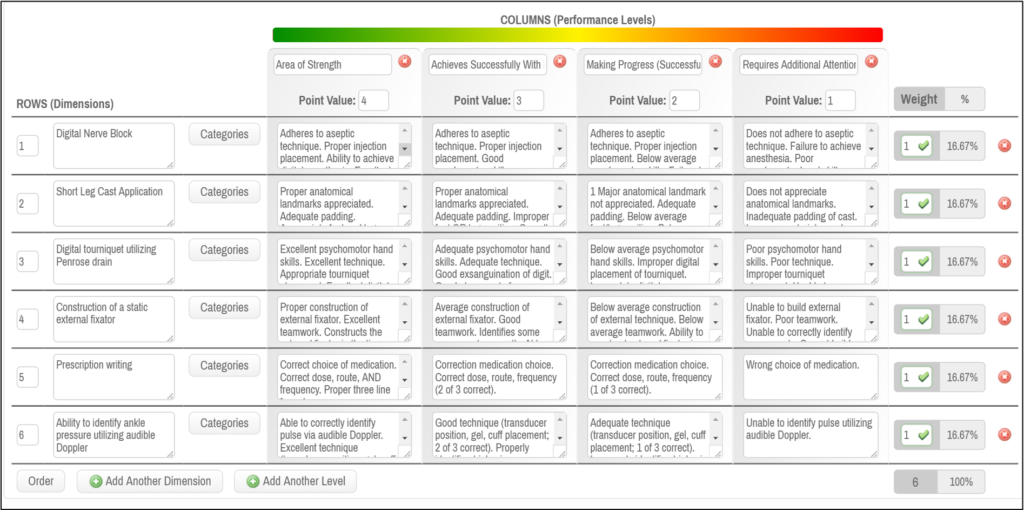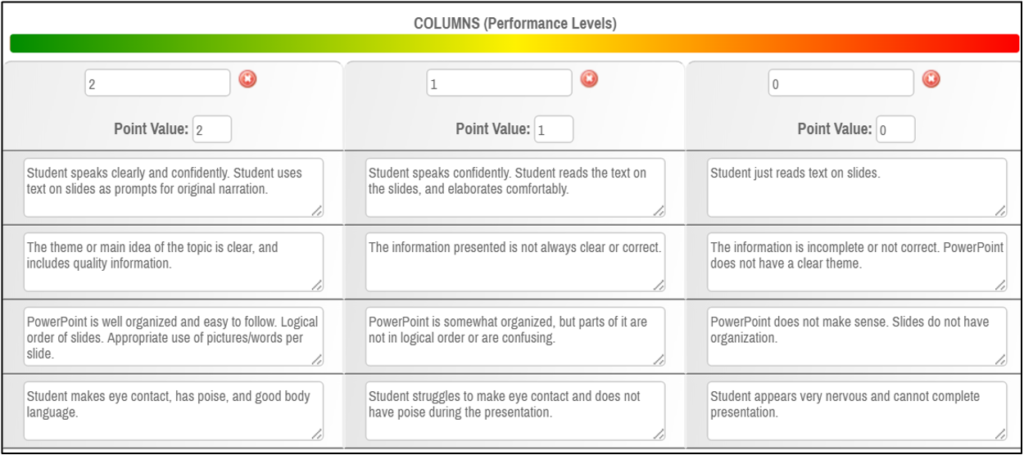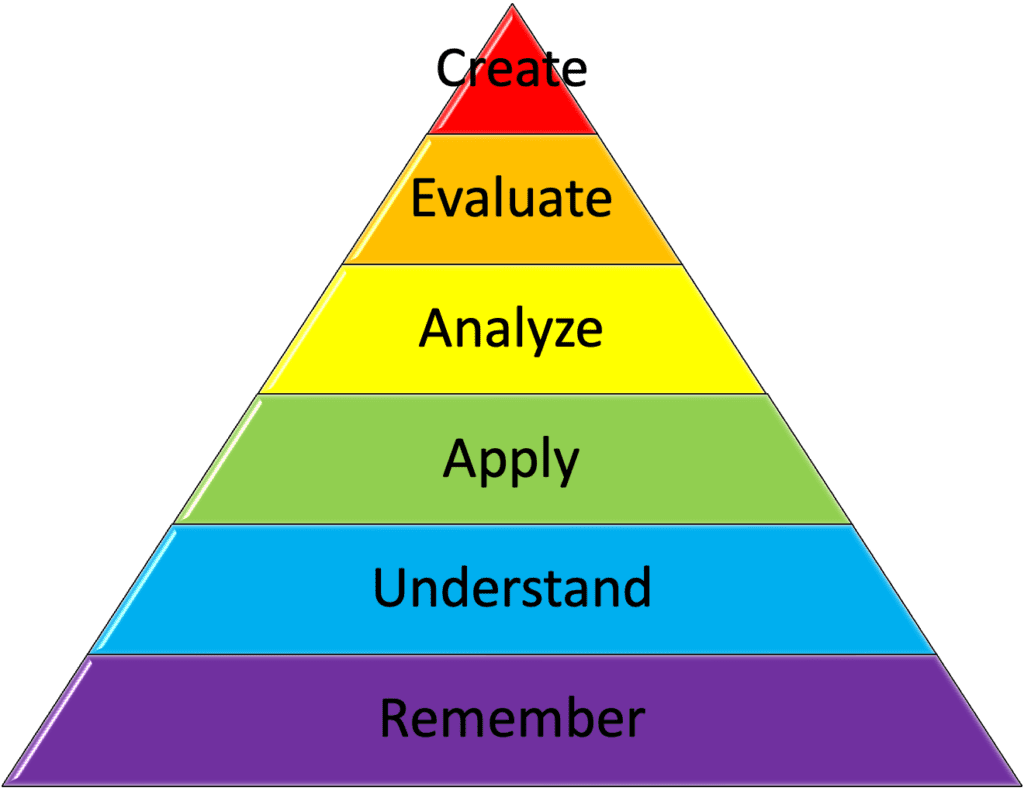Authored by Dr. Leland Jaffe, Associate Dean and Professor; Published on March 1st, 2024
Creating a rubric for student assessment involves defining clear criteria, outlining performance levels, and promoting a fair and consistent grading process. Whether it’s for grading assignments, research papers, evaluating oral presentations, or assessing a clinical/surgical skill, a rubric helps ensure consistency and fairness in the evaluation of student learning and provides excellent feedback. Rubrics can be utilized both for summative and formative assessments and this blog post will outline 10 important steps in developing a rubric for student assessment in higher education institutions.
Let’s dive right in:
Step 1: The First Step is to define the Purpose and Goals of a Rubric for Student Assessment
Understand the purpose of the assessment. What do you want to achieve by using this rubric? What skills or different criteria are you trying to measure?
The first crucial step in creating a new rubric for student assessment is to define its purpose and goals clearly. By establishing the intended outcomes and objectives of the assessment, educators can ensure that the rubric aligns closely with the learning objectives of the assignment or activity. Whether the goal is to evaluate students’ mastery of specific skills, assess their understanding of key concepts, or provide feedback for improvement, clarity and specificity are paramount.
Articulating the purpose and goals of the rubric not only guides its development but also sets clear expectations for students, helping them understand what is expected and how they will be evaluated. Ultimately, a well-defined rubric serves as a roadmap for both educators and students, facilitating fair, consistent, and meaningful assessment practices that support student learning and growth.
Numerous different types of rubrics exist such as:
- Analytic Rubric: This type of rubric breaks down the assessment criteria into separate components or dimensions, with each component evaluated individually. Analytic rubrics provide detailed feedback on specific aspects of student performance.
- Holistic Rubric: Unlike analytic rubrics, holistic rubrics assess overall performance on a single scale or criterion. They provide a broad assessment of student work without breaking it down into specific components.
- Primary Trait Rubric: Primary trait rubrics focus on a single dominant criterion or trait, such as creativity, organization, or problem-solving skills. They evaluate student performance primarily based on this key trait.
- Checklist Rubric: Checklist rubrics consist of a list of criteria or tasks that students must complete, with checkboxes indicating whether each criterion has been met. They are often used for simple assessments.
- Rating Scale Rubric: Rating scale rubrics use a numerical scale or descriptive labels to assess student performance across multiple criteria. They allow for more nuanced evaluation than checklist rubrics while still providing a structured framework for assessment.
- Performance Rubric: Performance rubrics are used to assess students’ performance on tasks or activities, such as presentations, performances, or projects. They focus on observable behaviors or outcomes rather than abstract qualities.
- Behavioral Rubric: Behavioral rubrics assess students’ behavior or conduct, such as participation, collaboration, or adherence to classroom rules. They provide feedback on students’ social and emotional skills as well as academic performance.
- Scoring Rubric: Scoring rubrics assign scores or grades to student work based on predefined criteria and performance levels. They help standardize grading and ensure consistency in assessment across different evaluators.
- Narrative Rubric: Narrative rubrics use written descriptions to evaluate student work, providing qualitative feedback rather than numerical scores. They focus on providing detailed feedback to students to support their learning and growth.
Step 2: Identify the Task or Project
After defining the purpose and goals of a rubric for student assessment, the next crucial step is to identify the specific task or project that will be assessed. This involves clearly defining the assignment, presentation, or performance task that students will complete and determining the specific criteria and expectations for evaluation. Educators must consider the complexity and scope of the task, as well as the learning objectives it aims to address. By clearly articulating the task or project, educators can ensure that the rubric accurately reflects the skills, knowledge, and competencies students are expected to demonstrate. Additionally, identifying the task or project allows educators to establish clear criteria for assessment, making it easier to provide targeted feedback and evaluate student performance effectively.
Step 3: Determine the Criteria
The subsequent step in crafting a rubric for student assessment is to determine the criteria by which student performance will be evaluated. This involves breaking down the task or project identified earlier into specific components or dimensions that reflect the learning objectives and expectations. Educators should consider the essential skills, knowledge, and competencies that students need to demonstrate to succeed in the task. These criteria should be clear, measurable, and aligned with the desired learning outcomes.
Additionally, educators may choose to prioritize certain criteria based on their relative importance or relevance to the task. By determining the criteria upfront, educators can establish a clear framework for assessment that guides both their evaluation process and students’ understanding of expectations, ultimately facilitating fair and consistent evaluation of student performance. List the specific set of criteria that will be used to evaluate the task. These should be clear, specific, and relevant to the task at hand. For example, if you’re grading a presentation, criteria might include content, delivery, visual aids, etc.
Step 4: Define Levels of Performance
Defining levels of performance in a rubric is crucial as it provides clarity and transparency regarding the standards of achievement for the assessed task or project. By delineating distinct levels of performance, educators can offer students a clear understanding of the expectations for success and progression. Each level represents a spectrum of proficiency, ranging from novice to mastery, allowing educators to differentiate between varying degrees of student achievement.
This nuanced approach enables educators to provide constructive feedback that identifies areas of strength and areas needing improvement. Moreover, well-defined levels of performance empower students to self-assess their work and set realistic goals for growth and development. Ultimately, establishing clear and descriptive levels of performance in a rubric fosters fairness, consistency, and accountability in the assessment process, enhancing the overall quality of feedback and supporting student learning outcomes.
Create a scale that represents different levels of performance for each criterion. Common scales include:
- Numeric Scale (e.g., 1-4 or 1-10): Assign a numerical value to each level of performance.
- Descriptive Scale (e.g., Excellent, Good, Fair, Poor): Use descriptive labels to represent different levels of performance.
- Qualitative Scale (e.g., Exemplary, Proficient, Developing, Not Evident): Provide qualitative descriptions of each level.

Step 5: Write Performance Level Descriptions for Each Level
For each criterion, describe what performance looks like at each level on the scale. Be clear and specific to avoid ambiguity in the grading criteria. Writing quality definitions at each level of a rubric is essential for providing clear guidance and transparency in the assessment process. These descriptions serve as benchmarks that articulate the specific criteria and expectations for each level of performance, ranging from exemplary to unsatisfactory. By including detailed descriptions, educators can effectively communicate the standards of achievement and provide students with a clear understanding of what is required to meet or exceed expectations.
Additionally, descriptive level descriptions help ensure consistency and objectivity in grading, as they provide a reference point for evaluating student work against predetermined criteria. Moreover, these descriptions facilitate constructive feedback by identifying areas of strength and areas needing improvement, thereby supporting students’ growth and development. Overall, incorporating descriptive level descriptions in a rubric enhances the fairness, reliability, and effectiveness of the assessment process, ultimately contributing to improved learning outcomes for students.

Step 6: Organize the Rubric
Arrange the criteria and corresponding levels in a logical order. Typically, criteria should be listed in a way that makes sense for the task. A well-organized rubric provides a structured framework that guides both educators and students through the evaluation process. By organizing criteria logically and sequentially, you can effectively communicate the hierarchy of importance and the relationship between different aspects of performance. This facilitates efficient grading and ensures that all relevant dimensions of student work are adequately addressed.
Further, a well-organized rubric helps students understand how their performance will be evaluated, enabling them to focus their efforts on meeting the specified criteria. Moreover, organizing a rubric fosters consistency and objectivity in assessment, as it helps educators apply grading standards uniformly across different assignments or students. Overall, a thoughtfully organized rubric enhances transparency, fairness, and reliability in the assessment process, ultimately supporting student learning and academic success.
Step 7: Test the Rubric
Evaluate a few sample projects or tasks using the rubric to ensure that they produce the expected results.
Testing the reliability of a rubric involves assessing the consistency and dependability of its scoring across different evaluators and/or multiple instances of assessment. Several methods can be employed to test the reliability of a rubric:
- Inter-Rater Reliability: This method involves comparing the scores assigned by different evaluators (raters) using the same rubric. A high level of agreement among raters indicates good reliability and overall indicates good rubrics.
- Test-Retest Reliability: This method assesses the consistency of scores over repeated assessments of the same work using the same rubric. Scores from the initial assessment are compared with scores from a subsequent assessment to determine the degree of consistency. Consistent scores across multiple administrations suggest good test-retest reliability.
- Internal Consistency Reliability: This method examines the internal consistency of the rubric by assessing the correlation between scores assigned to different criteria or components within the rubric.
- Parallel Forms Reliability: In this method, two versions of the same rubric are created to assess the same task or assignment. Scores assigned using both versions are compared to determine the degree of agreement between the two forms. High agreement between scores indicates good parallel forms reliability.
- Generalizability Analysis: This method involves analyzing the sources of variability in scores across different conditions or contexts to determine the overall reliability of the rubric. Factors such as raters, tasks, and occasions are considered to estimate the extent to which scores can be generalized.
Prolonged testing of a rubric is particularly crucial for high-stakes summative assessments due to the significant impact of the assessment outcomes on students’ academic progression and achievement. In high-stakes settings, such as final exams or standardized tests, the reliability and validity of the rubric are paramount to ensure fair and accurate evaluation of student performance.
Which Type of Rubric For Student Assessment Requires Prolonged Testing?
Prolonged testing allows educators to thoroughly assess the rubric’s effectiveness in various contexts and with diverse student populations, identifying any potential biases, inconsistencies, or areas for improvement. By rigorously testing the rubric over an extended period, educators can enhance its reliability, validity, and overall quality, thereby ensuring that assessment results accurately reflect students’ knowledge, skills, and abilities. This meticulous approach to rubric testing helps to maintain the integrity and credibility of high-stakes summative assessments, ultimately promoting fairness and equity in rubric-based assessments.
By employing these methods, educators can assess the reliability of a rubric and make informed decisions about its validity and effectiveness in evaluating student performance consistently and accurately.
Step 8: Finalize the Rubric
Create a clean and organized version of the rubric for distribution or use. You can use a table format or a graphic design tool to make it visually appealing.
Finalizing the rubric is the last step in the rubric development process and involves several key actions to ensure its readiness for implementation:
- Review and Revision: Before finalizing the rubric, it is essential to review the entire document carefully. This includes reviewing the criteria, descriptions, levels of performance, and overall organization to ensure clarity, accuracy, and alignment with the intended purpose and goals of the assessment. Any necessary revisions or adjustments should be made based on feedback from stakeholders, including educators and subject matter experts.
- Pilot Testing: It is beneficial to pilot-test the rubric with a small group of students or colleagues to assess its usability, reliability, and validity in practice. Pilot testing provides an opportunity to identify any potential issues or areas for improvement before full implementation.
- Training and Familiarization: Educators who will be using the rubric should be provided with training and guidance on how to use it effectively. This may include instruction on how to interpret the rubric, apply it to student work, and provide feedback based on the criteria and levels of performance.
- Documentation and Dissemination: Once finalized, the rubric should be documented and disseminated to all relevant stakeholders, including educators, students, and administrators. Clear documentation ensures that everyone understands how the rubric will be used and what is expected of them in the assessment process.
- Feedback Mechanisms: Establishing feedback mechanisms is important to gather input and insights from stakeholders about the rubric’s effectiveness and utility. This may involve soliciting feedback through surveys, focus groups, or other forms of communication to identify areas for improvement and inform future revisions.
- Continuous Evaluation and Improvement: After implementation, ongoing evaluation and monitoring of the rubric’s effectiveness should occur. This includes collecting data on its reliability, validity, and impact on student learning outcomes, as well as soliciting feedback from stakeholders for continuous improvement.
Step 9: Provide Clear Instructions
When using the rubric, provide clear instructions to those who will be assessed. Explain how it will be used in the learning process and how overall grades will be determined.
Providing a rubric to students before the assessment is generally beneficial for several reasons:
- Clarity of Expectations: Sharing the rubric with students clarifies the specific criteria and expectations for the assessment, helping them understand what is required to succeed. This transparency fosters a sense of fairness and reduces ambiguity about how their work will be evaluated.
- Guidance for Improvement: By seeing the criteria and levels of performance outlined in the rubric, students can identify areas where they may need to improve and focus their efforts accordingly. This helps them to target their learning and make informed decisions about how to approach the assignment or task.
- Opportunity for Self-Assessment: Access to the rubric enables students to engage in self-assessment, evaluating their work against the established criteria before submitting it for formal evaluation. This encourages metacognition and reflection, empowering students to take ownership of their learning and strive for excellence.
- Enhanced Feedback Reception: When students understand the criteria by which their work will be evaluated, they are better equipped to interpret and act upon feedback provided by instructors. This facilitates more meaningful and targeted feedback conversations, leading to deeper understanding and skill development.
- Promotion of Academic Integrity: Providing the rubric upfront reinforces the importance of academic integrity and ethical conduct. Students understand the expectations for originality and quality in their work, reducing the likelihood of unintentional plagiarism or academic misconduct.
Step 10: Use and Review
Apply the rubric consistently to assess tasks or projects. Periodically review the rubric to ensure it remains relevant and effective. As a general guideline, rubrics should be reviewed regularly to ensure their ongoing effectiveness and relevance. This may involve periodic reviews at the end of each academic term or semester, as well as more comprehensive evaluations on an annual or biennial basis.
Additionally, rubrics should be reviewed whenever there are significant changes to the curriculum, learning outcomes or objectives, or assessment methods, as these changes may necessitate adjustments to the rubric criteria or descriptions. Moreover, soliciting feedback from students, educators, and others can provide valuable insights into the rubric’s strengths and weaknesses, informing future revisions. Ultimately, the goal of rubric review is to maintain the quality, validity, and fairness of assessment practices, thereby supporting student learning and success.
Rubric For Student Assessment – Conclusion
Remember, a well-designed rubric is clear, specific, and aligned with the goals of the assessment and can be used for a variety of assignments. It should make the evaluation process fair and transparent for both assessors and those being assessed. Creating a rubric is an important tool for enhancing assessment practices and promoting student learning. By carefully defining the purpose and goals of the rubric, identifying the task or project to be assessed, determining clear criteria, and organizing the rubric effectively, educators can develop a comprehensive framework for evaluating student performance.
Incorporating descriptive level descriptions and finalizing the rubric through review, pilot testing, and documentation ensures its readiness for implementation. Providing the rubric to students before the assessment promotes transparency, clarity, and self-regulation, ultimately leading to improved learning outcomes. As educators continue to refine and adapt their rubrics based on feedback and evaluation, they can enhance the fairness, consistency, and effectiveness of their assessment practices, ultimately supporting student success in the classroom and beyond.
Comment below on how you’ve used rubrics to assess your students’ performance in the classroom or clinical settings.
Additional Resources:
Carnegie Melon University Eberly Center for Teaching Excellence & Educational
Innovationhttps://www.cmu.edu/teaching/assessment/assesslearning/rubrics.html
Yale Center for Teaching and Learning https://poorvucenter.yale.edu/Rubrics







